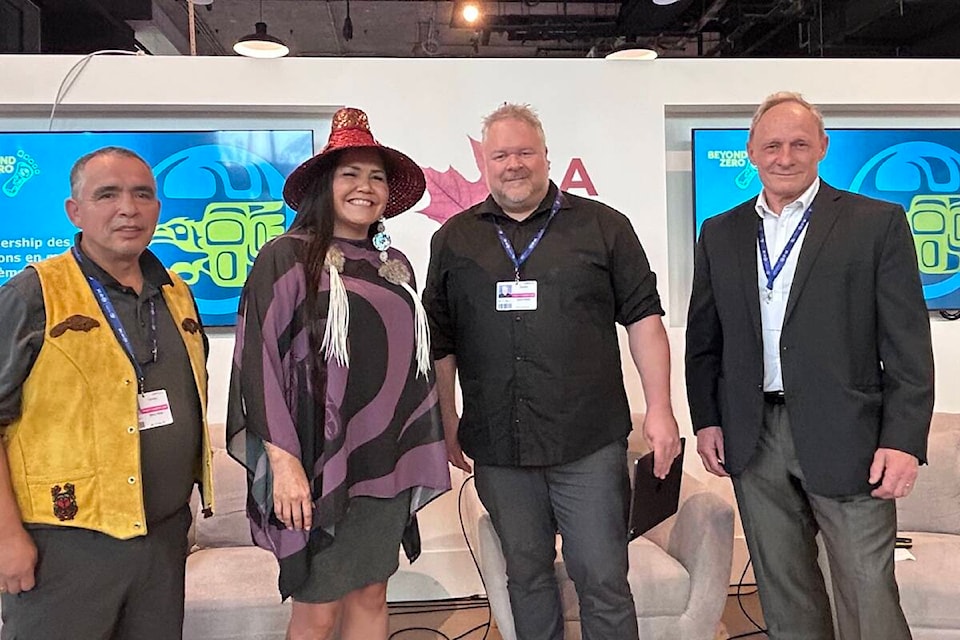Two hundred countries agreeing for the first time to move away from fossil fuels captured the biggest world headlines at the COP28 conference in Dubai.
But a smaller B.C. contingent working on the sidelines was also finding partnerships and solutions that could help the world reach its greenhouse gas emission goals.
The First Nations Climate Initiative (FNCI), a collaboration of four Northwest B.C. communities: the Lax Kwsa���ʴ�ý�alaams, Metlakatla, Nisgasa���ʴ�ý�a and Haisla First Nations. Each is looking to fight climate change while alleviating poverty. COP28 progressed their goal of creating green shipping corridors with a memorandum of understanding signed with several Asian countries.
Alex Grzybowski, who has been working with the group since before the initiativesa���ʴ�ý�s inception, said Indigenous people are on the front line of climate change. Many are experiencing its impacts in their communities and their connection to the land and water means theysa���ʴ�ý�re very familiar with every change.
sa���ʴ�ý�Their interest in mitigating and adapting to climate change is as strong as anyonesa���ʴ�ý�s,sa���ʴ�ý� Grzybowski said in an interview.
Liquefied natural gas (LNG) projects in the territories of two member nations fuelled their concern about whether the fuel would help alleviate climate change or be part of the problem, he said.
Their focus turned to helping create a green corridor that would decarbonize every part of the global shipping industry, both on land and at sea. Having fossil fuel-powered ports use zero-emission fuels would be major shift, Grzybowski said, but it comes as new enterprises and infrastructure are emerging to make the transition possible.
sa���ʴ�ý�In the Canadian context, who should own all that? The last time we built the economy, First Nations ended up being bystanders and didnsa���ʴ�ý�t end up owning the major infrastructure,sa���ʴ�ý� Grzybowski said.
The same communities that were once removed from those opportunities now want to be leaders this time around. The First Nations Climate Initiative aims to leverage its stake in the carbon-based gas to transition into the emerging hydrogen sector sa���ʴ�ý� while being the model in how to do just that.
A report commissioned by the First Nations group found the natural gas projects theysa���ʴ�ý�re involved in could help decarbonize steel manufacturing in Asia, especially South Korea since itsa���ʴ�ý�s a major producer of the emissions intensive material.
Those hopes materialized at COP28sa���ʴ�ý�s Korean pavilion, where the Nationssa���ʴ�ý� delegates met a company that will be converting its steel feedstock from coal to natural gas.
It would then use an emission-free process called methane pyrolysis to extract hydrogen that would power the steel manufacturing while solidifying the natural gassa���ʴ�ý� carbon sa���ʴ�ý� rather than emitting it sa���ʴ�ý� into materials that can be used in things like roads, tires and batteries.
sa���ʴ�ý�Thatsa���ʴ�ý�s what the Koreans are thinking of doing and thatsa���ʴ�ý�s an opportunity for Canada, and particularly First Nations in Canada to contribute,sa���ʴ�ý� Grzybowski said. sa���ʴ�ý�Wesa���ʴ�ý�re probably not going to stop using steel, so we need to manufacture it in a way that doesnsa���ʴ�ý�t produce GHGs.sa���ʴ�ý�
COP28 also saw the First Nations Climate Initiative present the progress itsa���ʴ�ý�s made on its climate action plan, especially using nature-based solutions to mitigate climate change. The four Nations and others theysa���ʴ�ý�ve partnered with are strongly interested in recovering ecosystems in their territories that have been degraded and led to cultural connections to the land being lost.
sa���ʴ�ý�Recovery of those ecosystems is very important to their cultures,sa���ʴ�ý� Grzybowski said.
The initiative has brought nature-based solution recommendations to the province, which are in the process of being implemented. Those also include tapping into the multi-billion dollar carbon credit market that could see the natural carbon sinks used as a revenue source.
While at COP28, among the many seemingly unthinkable innovations Grzybowski saw was a Japanese freighter equipped with turbine-like sails that would create electricity. That electricity would then be used to desalinize ocean water before extracting hydrogen from the resulting fresh water.
sa���ʴ�ý�It was inspiring and it was also confidence building to know that there are solutions and we need to pursue them.sa���ʴ�ý�
READ: sa���ʴ�ý�



